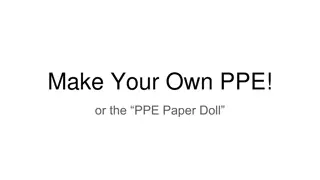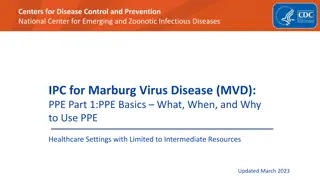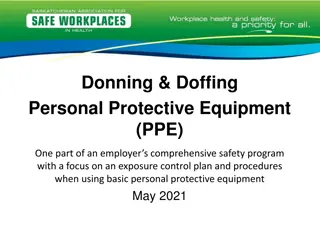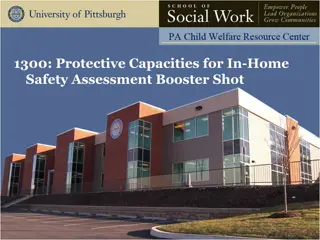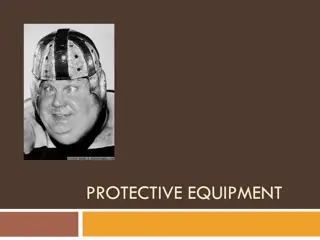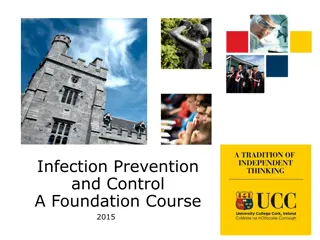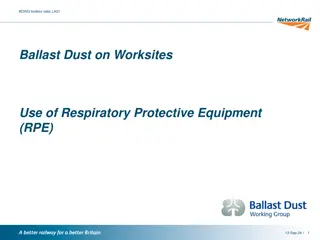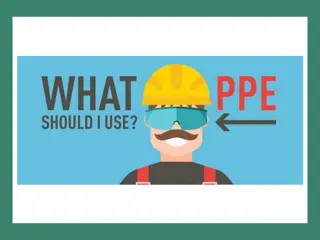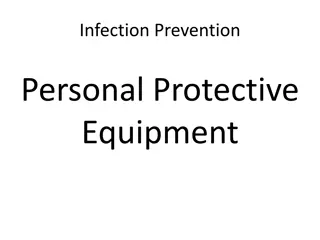Guidelines on Rational Use of Personal Protective Equipment for COVID-19
Healthcare workers caring for COVID-19 patients need to use Personal Protective Equipment (PPE) appropriately to protect themselves and prevent transmission. This includes proper selection, training on how to use, dispose of PPE, and reduce the risk of pathogen transmission. The outbreak of COVID-19, caused by the SARS-CoV-2 virus, started in Wuhan, China, and has spread worldwide. Close contact with infected individuals increases the risk of transmission. PPE components include goggles, face shields, masks, gloves, gowns, head covers, and shoe covers.
Download Presentation

Please find below an Image/Link to download the presentation.
The content on the website is provided AS IS for your information and personal use only. It may not be sold, licensed, or shared on other websites without obtaining consent from the author. Download presentation by click this link. If you encounter any issues during the download, it is possible that the publisher has removed the file from their server.
E N D
Presentation Transcript
Guidelines on Rational use of Personal Protective Equipment Novel Corona virus Disease 2019 (COVID Guidelines on Rational use of Personal Protective Equipment- - Novel Corona virus Disease 2019 (COVID- -19) 19) State Institute of Health and Family Welfare- Rajasthan 1
Need of the PPE Need of the PPE Additional precautions are required by health care workers to protect themselves and prevent transmission in the healthcare setting. Precautions to be implemented by health care workers caring for patients with COVID-19 include using PPE appropriately; this involves selecting proper PPE and being trained in how to put on, remove, and dispose of it Reduce the risk of transmission of blood borne and other pathogens from both recognized and unrecognized sources. Ref:-Rational use of personal protective equipment (PPE) for coronavirus disease (COVID-19) Interim guidance 19 March 2020 2
Presentation Useful For Presentation Useful For Health care workers and others working in points of entries (POEs) Quarantine centers Hospitals Laboratory Community settings 3
Introduction Introduction- -COVID COVID- -19 19 The outbreak of Novel coronavirus disease (COVID- 19) was initially noticed from a seafood market in Wuhan city in China in mid-December, 2019, has spread to more than 185 countries/territories worldwide including India. The causative agent for COVID-19, earlier termed provisionally as novel Coronavirus has been officially named as SARS-CoV-2. 4
Mode of Transmission Mode of Transmission The people most at risk of COVID-19 infection are those who are in close contact with a suspect/confirmed COVID-19 patient or who care for such patients. 5
Personal Protective Equipment (PPE) Personal Protective Equipment (PPE) Personal Protective Equipments (PPEs) are protective gears designed to safeguard the health of workers by minimizing the exposure to a biological agent. 6
Components of PPE Goggles Face-shield Mask Gloves Gowns Head cover Shoe cover 7
Face shield and goggles Face shield and goggles Protection of the mucous membranes of the eyes/nose/mouth (droplets generated by cough, sneeze of an infected person or during aerosol generating procedures) by using face shields/ goggles is an integral part of standard and contact precautions. The flexible frame of goggles should provide good seal with the skin of the face, covering the eyes and the surrounding areas and even accommodating for prescription glasses. Ref: Novel Coronavirus Disease 2019 (COVID-19): Guidelines on rational use of Personal Protective Equipment 8
Masks Masks Coronaviruses target mainly the upper and lower respiratory tracts. The droplet precautions/airborne precautions using masks are crucial while dealing with a suspect or confirmed case of COVID- 19/performing aerosol generating procedures. There are two types of masks which are recommended for various categories of personnel working in hospital or community settings, depending upon the work environment: 1. Triple layer medical mask 2. N-95 Respirator mask Ref: Novel Coronavirus Disease 2019 (COVID-19): Guidelines on rational use of Personal Protective Equipment 9
Triple Layer Medical Mask Triple Layer Medical Mask A triple layer medical mask is a disposable mask, fluid-resistant, provide protection to the wearer from droplets of infectious emitted coughing/sneezing/talkin g. material during Ref: Novel Coronavirus Disease 2019 (COVID-19): Guidelines on rational use of Personal Protective Equipment 10
N N- -95 Respirator mask 95 Respirator mask An N-95 respirator mask is a respiratory protective device with high filtration airborne particles. Such mask should have high fluid resistance, breathability (preferably with an expiratory valve), identifiable internal and external faces, duckbill/cup-shaped structured design that does not collapse against the mouth. If correctly worn, the filtration capacity of these masks exceeds those of triple layer medical masks. efficiency to good clearly Ref: Novel Coronavirus Disease 2019 (COVID-19): Guidelines on rational use of Personal Protective Equipment 11
Gloves Gloves To be a predominant mode of care should be exercised while objects/surface potentially contaminated suspect/confirmed cases of COVID-19. transmission, handling by Ref: Novel Coronavirus Disease 2019 (COVID-19): Guidelines on rational use of Personal Protective Equipment 12
Gowns Gowns Coverall/gowns are designed to protect of healthcare providers from exposure to virus. Coveralls typically provide 360-degree protection because they are designed to cover the whole body, including back and lower legs and sometimes head and feet as well, the design of medical/isolation gowns do not provide continuous whole-body protection (e.g., possible openings in the back, coverage to the mid-calf only). By using appropriate protective clothing, it is possible to create a barrier to eliminate or reduce contact and droplet exposure, both known to transmit COVID-19 13
Shoe covers Shoe covers Shoe covers should be made impermeable fabric to be used over shoes to facilitate protection decontamination. up of personal and 14
Head covers Head covers Head cover that covers the head and neck while providing clinical care for patients. Hair and hair should fit inside the head cover. extensions 15
SEQUENCE FOR PUTTING ON PERSONAL PROTECTIVE EQUIPMENT (PPE) Personal Protection Equipment (PPE) - Specifications 16
Ensure rational and appropriate use of PPE PPE is only one effective measure within a package of administrative and environmental and engineering controls. as described in WHO s Infection prevention and control of epidemic- and pandemic-prone acute respiratory infections in health care. These controls are summarized here. Ensure rational and appropriate use of PPE 17
Administrative Controls Administrative Controls Ensuring resources for infection prevention and control (IPC) measures, such as- appropriate infrastructure Development of clear IPC policies Facilitated access to laboratory testing Appropriate triage and placement of patients Adequate staff-to-patient ratios Training of staff 18
Rational use of PPE Rational use of PPE PPE should be used in combination with administrative and engineering controls. PPE should be used based on the risk of exposure (e.g. type of activity) and the transmission dynamics of the pathogen(e.g. contact, droplet or aerosol). The overuse of PPE will have a further impact on supply shortages. 19
PPEs to be Used in Different Settings The PPEs are to be used based on the risk profile of the health care worker. The document describes the PPEs to be used in different settings. PPEs to be Used in Different Settings 20
Minimize the need for PPE in health care settings Wherever feasible, use telemedicine and telephone to initially evaluate suspected cases of COVID-19, thus minimizing the need for these persons to go to health care facilities for evaluation. Use physical barriers to reduce exposure to the COVID-19 virus, such as glass or plastic windows such as -screening areas, the registration desk at the emergency department, or at the pharmacy window Postpone elective, non-urgent procedure, and hospitalizations, reduce frequency of visits for chronic patients Minimize the need for PPE in health care settings Ref: Rational use of personal protective equipment for coronavirus disease (COVID-19) and considerations during severe shortages Interim guidance 6 April 2020 21
Designate dedicated health care workers/teams only for COVID-19 patient care so that they can use PPE for longer periods of time (extended use of PPE). Restrict the number of health care workers from entering the rooms of COVID-19 patients if they are not involved in providing direct care Consider using specific PPE only if in direct close contact with the patient or when touching the environment Visitors should not be allowed Ref: Rational use of personal protective equipment for coronavirus disease (COVID-19) and considerations during severe shortages Interim guidance 6 April 2020 22
PPE Supply Chain Management Mechanisms PPE Supply Chain Management Mechanisms Using quantification rationalization of requested supplies; Monitoring and controlling PPE requests from responders Promoting a centralized request management approach to avoid duplication of stock PPE forecasts models based to on ensure rational the 23
Ensuring strict adherence to essential stock management rules to limit wastage, overstock, and stock ruptures Monitoring the end-to-end distribution of PPE Monitoring and controlling the distribution of PPE from medical facilities stores. 24
Points to remember while using PPE PPEs are not alternative to basic preventive public health measures. Hand hygiene, respiratory etiquettes which must be followed at all times. Always maintain a distance of at least 1 meter from contacts/suspect/confirmed COVID-19 cases Always follow the laid down protocol for disposing off PPEs as detailed in infection prevention and control guideline available on website of MoHFW. Points to remember while using PPE 25
Thank You 26




